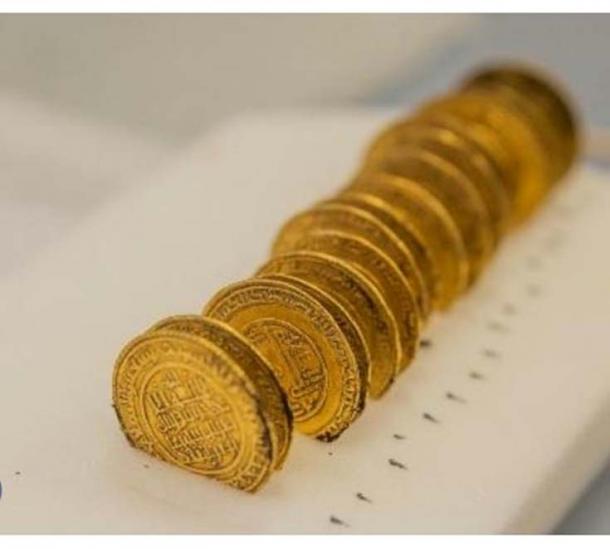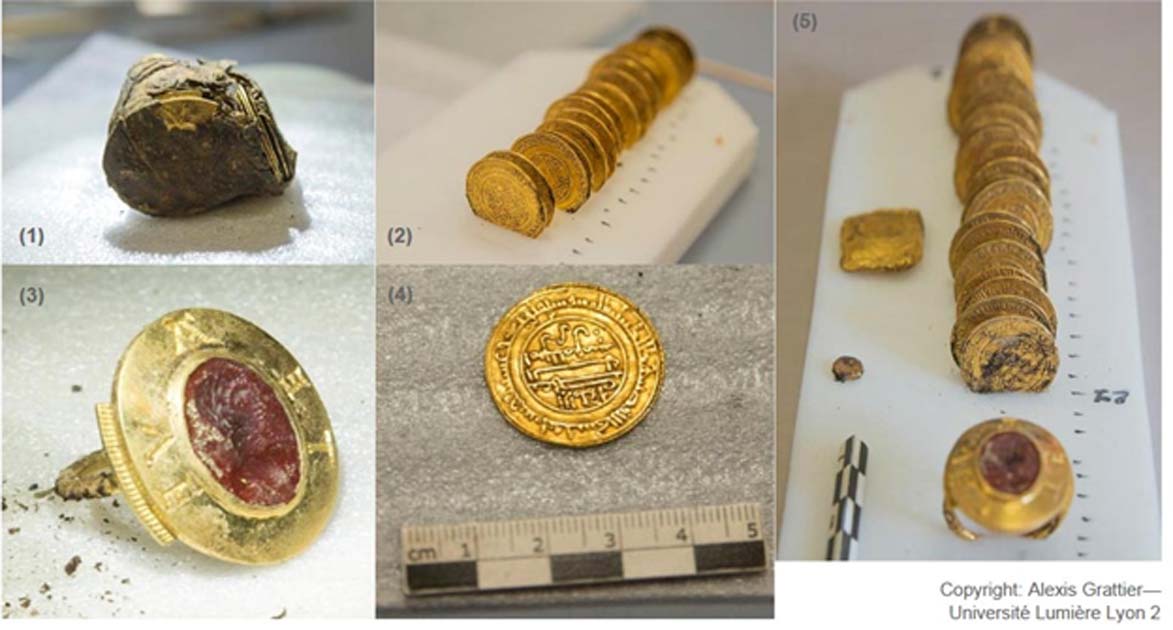Medieval Treasure Unearthed at the Abbey of Cluny
In mid-September, a large treasure was unearthed during a dig at the Abbey of Cluny, in the French department of Saône-et-Loire: 2,200 silver deniers and oboles, 21 Islamic gold dinars, a signet ring, and other objects made of gold. Never before has such a large cache of silver deniers been discovered. Nor have gold coins from Arab lands, silver deniers, and a signet ring ever been found hoarded together within a single, enclosed complex.
Anne Baud, an academic at the Université Lumière Lyon 2, and Anne Flammin, a CNRS engineer - both from the Laboratoire Archéologie et Archéométrie (CNRS / Université Lumière Lyon 2 / Claude Bernard Lyon 1 University) -- led the archaeological investigation, in collaboration with a team of 9 students from the Université Lumière Lyon 2 and researchers from the Maison de l'Orient et de la Méditerranée Jean Pouilloux (CNRS / Université Lumière Lyon 2).

Gold dinars were found. (Credit: Alexis Grattier-Université Lumière Lyon 2)
The excavation campaign, authorized by the Bourgogne-Franche-Comté Regional Department of Cultural Affairs (DRAC), began in mid-September and ended in late October. It is part of a vast research program focused on the Abbey of Cluny. Students in the Master of Archaeology and Archaeological Science program at the Université Lumière Lyon 2 have been participating in archaeological digs at the Abbey of Cluny since 2015. This experience in the field complements their academic training and gives them an insight into professional archaeology.
- Scattered but Not Forgotten: The Amazing Ancient Persian Gold and Silver Oxus Treasure
- Ten Spectacular Golden Treasures of the Ancient World
- Could Clues From the Ocean Floor Finally Lead to Zheng He’s Lost Treasure Ship?

Cluny Abbey (or Cluni, or Clugny) is a Benedictine monastery in Cluny, Saône-et-Loire, built in Romanesque style (CC BY 2.0)
At the site, the team led by Anne Baud et Anne Flammin, including the students from the Université Lumière Lyon 2, discovered a treasure consisting of:
- more than 2,200 silver deniers and oboles - mostly minted by the Abbey of Cluny and probably dating to the first half of the 12th century - in a cloth bag, traces of which remain on some of the coins. A tanned hide bundle, found among the silver coins, fastened with a knot, and enclosing
- 21 Islamic gold dinars struck between 1121 and 1131 in Spain and Morocco, under the reign of Ali ibn Yusuf (1106-1143), who belonged to the Berber Almoravid dynasty.
- a gold signet ring with a red intaglio depicting the bust of a god and an inscription possibly dating the ring back to the first half of the 12th century
- a folded sheet of gold foil weighing 24 g and stored in a case
- a small circular object made of gold

The gold dinars were found in a tanned hide bundle. (Credit: Alexis Grattier-Université Lumière Lyon 2)
Vincent Borrel, a PhD student at the Archaeology and Philology of East and West (CNRS / ENS) research unit - AOROC for short - is currently studying the treasure in more detail to identify and date the various pieces with greater precision.
- Huge Hoard of Ancient Roman Silver Coins Worth £200,000 Found During Treasure Hunt
- Treasure Hunter that Found Unique Viking hoard to be Awarded £2 Million
- The Secret Tunnels and Missing Manuscripts of Mont Sainte-Odile Abbey

In 1790 during the French Revolution, the abbey was sacked and mostly destroyed. (CC BY 2.0)
A Precious Find
This is an exceptional find for a monastic setting and especially that of Cluny, which was one of the largest abbeys of Western Europe during the Middle Ages. The treasure was buried in fill where it seems to have stayed for 850 years.
It includes items of remarkable value: 21 gold dinars and a signet ring, a very expensive piece of jewelry that few could own during the Middle Ages. The use of signet rings during the Middle Ages is frequently attested. They served various domestic functions, being used to seal coffers, money pouches, and correspondence.

Signet ring found at Cluny Abbey (Credit: Alexis Grattier-Université Lumière Lyon 2)
At that time, Western currency was mostly dominated by the silver denier. Gold coins were reserved for rare transactions. The 2,200 or so silver deniers, struck at Cluny or nearby, would have been for everyday purchases. This is the largest stash of such coins ever found.
The fact that Arab currency, silver deniers, and a signet ring were enclosed together makes this discovery all the more interesting.
New avenues of research into the history of the Abbey of Cluny
This discovery will breathe new life into research delving into the past of the abbey, a historic site open to the public and managed by the Centre des Monuments Nationaux (CMN). It also raises new questions worth answering:
- Who owned the treasure? Was it a monk, a church dignitary, or a rich layman?
- What can the coins teach us? Where were the silver deniers of Cluny struck? Where did they circulate? How did Islamic dinars minted in Spain and Morocco end up at Cluny?
- Why was the treasure buried?
- What building lay above the treasure when it was hidden? Was it a building, now in ruins, that we know little about?
Top image: (1) Knotted tanned hide bundle before extraction of contents; (2) & (4) gold dinars; (3) signet ring with intaglio; (5) contents of knotted tanned hide bundle.
Credit: © Alexis Grattier— Université Lumière Lyon 2
Source: CNRS. "Archaeology: Medieval treasure unearthed at the Abbey of Cluny." ScienceDaily. ScienceDaily, 14 November 2017. www.sciencedaily.com/releases/2017/11/171114091950.htm


















Comments
I am wondering if that purse with a handle, was found with this treasure ? That purse i refer to is depicted throughout more ancient cultures going back well into BC times, across many those nations. They are found on their carvings and drawings.
I mean coins and wearables wear found together, how were they thus carried together ?
Certainly not some square box ! The ring may have been for that certain person to wear, to show others their status, that they are to not to be trifled with, since they carried that purse, with messages, gifts from one king to another or leader to leader between lands. But, was the purse done away with long before medieval times ? What is the LATEST known find so far, of this purse i refer to ?
Be better if they read and included here what the coins say on them, and the ring. but so much they seem to hide....? More pics too.. cant be all that was there is what they show us..
This is a most wonderful find and from the looks of it, the pieces are in very good shape. Great article, very interesting. Finds like this always never fail to amaze me!